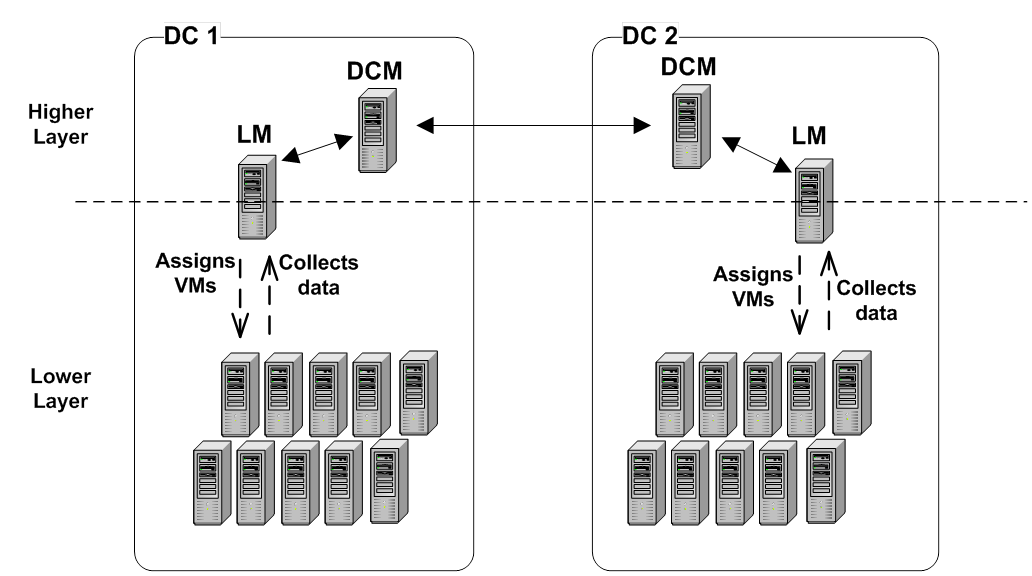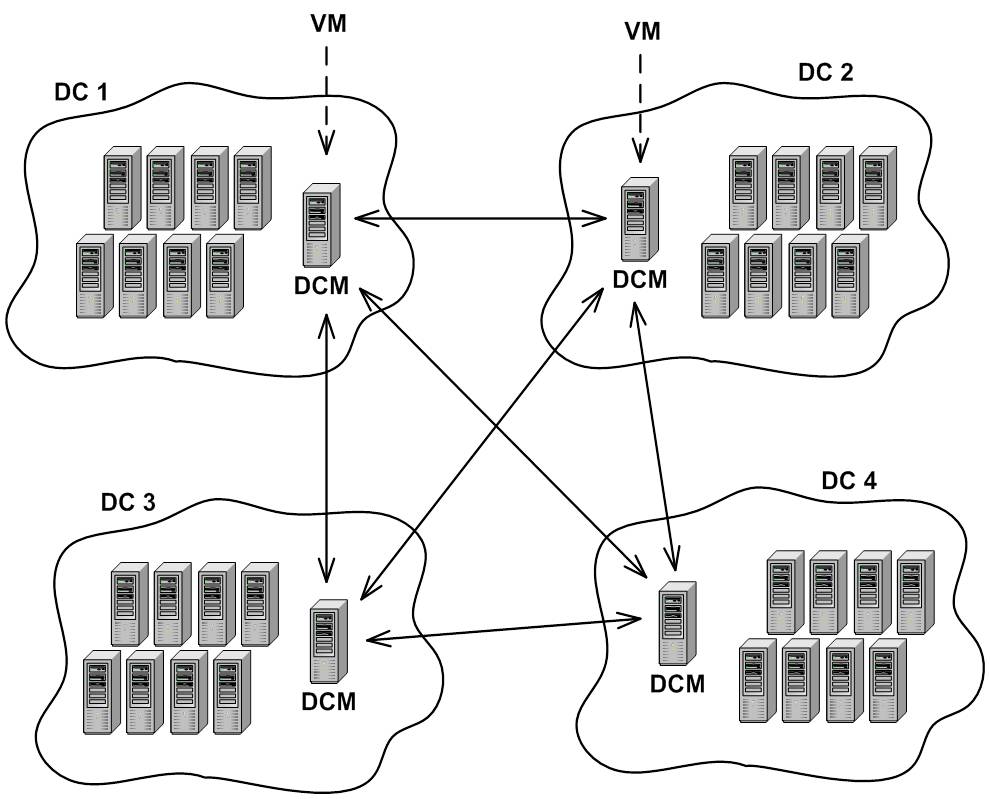- Eco4Cloud introduces EcoInterCloud and takes intercloud to the next level of intelligent workload mobility
Eco4Cloud introduces EcoInterCloud and takes intercloud to the next level of intelligent workload mobility
Rende, Italy – February 11th, 2015 - Eco4Cloud (www.eco4cloud.com) –global leader in intelligent workload management solutions for virtualized data centers and the cloud– today announces EcoInterCloud. EcoInterCloud extends Eco4Cloud’s native intra-datacenter workload consolidation algorithm and award‑winning solutions to work across multiple datacenters and improve efficiency, resiliency and policy‑driven optimizations within so called intercloud architectures.
The potential improvements provided by cloud technologies are often overlooked, as 451 Research articulates in its “Eco4Cloud Floats the Concept of the EcoInterCloud for Datacenter IT Efficiency” Impact report, and the notion of intercloud is set to drive the next stage in Cloud adoption. Intercloud in fact is meant as a set of hybrid cloud architectures which enable and automate the seamless mobility of workloads within and between multiple cloud instances. Intercloud is clearly enjoying a growing popularity and has already become an arena for competitive differentiation among heavyweight industry leaders such as Cisco, HP, VMware, IBM and others who are touting their respective strategies and architectural frameworks in this space.
Eco4Cloud sees intercloud as ideal to maximize the native technical and business benefits of its innovative and award‑winning workload management technology, significantly contributing to the level of intelligence by which bidirectional workload mobility is managed and –ideally– automated in policy‑driven intercloud implementations.
Eco4Cloud has in fact identified a number of drivers for its EcoInterCloud architecture and solutions:
- Host Thin Provisioning™: autonomically provisioning only the number of physical servers and cores that applications need at any given time, by dynamically consolidating workloads and switching on/off physical cores in real-time hence maximizing the utilization of available computing resources (i.e., CPU, RAM) and power managing or decommissioning the remainder. With EcoInterCloud this capability is now applied to multiple geographically distributed facilities and clouds.
- Cost reduction: EcoInterCloud can be used to bidirectionally shift workloads between facilities depending on a variety of policy‑set criteria, such as to max out the utilization of available capacity, to take advantage of the price and/or availability of electricity at different sites, or dynamically price‑brokering multiple public-cloud providers as workloads can also be shifted between sites at different times of the day or night (a process also known as “follow the moon”) based on related cost and/or convenience.
- SLA and Quality of Service Management: organizations that manage multiple datacenters may want to ensure workloads are proportionally balanced across sites in order to improve the responsiveness of specific sites and reduce the impact on physical infrastructure such as power and cooling systems. In fact the workload must be distributed without overloading any individual site. This in fact may affect the quality of the service, which on the other hand may be improved by intelligently combining applications (i.e., VMs) having complementary characteristics (e.g., CPU-bound with RAM-bound applications).
- Load Balancing: in a multi-DC/Cloud environment –especially if managed by the same organization– it may be crucial to properly balance the load distributed across different sites, as a better balance may help improve the responsiveness of the individual sites, decrease the impact on physical infrastructure –e.g., in terms of cooling and power distribution–, and help prevent overload conditions.
- Inter-DC traffic reduction: Eco4Cloud’s EcoInterCloud architecture can also be functional to intelligently determining which workloads should remain within a specific facility rather than being migrated to another site, as in fact not all workloads are equally portable –especially those associated with large data sets– and the amount of inter-DC bandwidth and/or latency could also be a limiting factor to consider. So, in some cases it is more efficient to assign a VM to the local data center instead of moving it to a remote data center depending on many factors, among which the amount of data used by the VM, the available inter-DC bandwidth and the type of applications hosted by the VMs. For example, choosing a local data center is more convenient if the VM hosts a database server as opposed to a web service just because of the intrinsic characteristics of the respective VMs.
All of these drivers may have different relevance and priority for individual data centers or Companies, and EcoInterCloud enables the intelligent combination of choice delivering efficiency and flexibility combined. In fact, the efficiencies and optimizations which EcoInterCloud introduces to an intercloud environment deliver value on multiple fronts, effectively being based on a novel and distinct degree of additional architectural intelligence by which intercloud implementations can operate. These functional values are further enriched by the inherent and differentiating attributes of Eco4Cloud’s algorithm, i.e.: unlimited scalability, technology platform independence, real‑time adaptation, unified management.
«EcoInterCloud truly raises the bar of the architectural intelligence and differentiated value of intercloud solutions, delivering tangible benefits to end users and Cloud providers alike. Eco4Cloud keeps innovating in one of the hottest spaces of IT, contributing to the evolution of cloud architectures and we’re thrilled for the opportunity ahead,» said Roberto Mircoli, CEO of Eco4Cloud.
«The potential datacenter efficiency improvements provided by cloud technologies are often overlooked due to the disconnect between IT and facilities management. Eco4Cloud appears to be taking a lead in this area with EcoInterCloud and courting some of the right potential partners. EcoInterCloud should benefit from growing interest in intercloud, software-driven datacenters and the touch points between DCIM and cloud orchestration,» said Andrew Donoghue, European Research Manager, 451 Research.
EcoInterCloud Architecture
The EcoInterCloud architecture for the efficient and autonomic management of the workload in a multi-DC/Cloud scenario is hierarchical and composed of two layers:
- an upper‑layer to exchange information among the different sites and drive the distribution of Virtual Machines (VMs) among the geographically distributed data centers
- a lower‑layer to manage the workload within individual data centers.
This 2‑layers architecture allows most of the intelligence to be maintained within the individual data centers (i.e., the lower‑layer), which can then implement their workload optimization policies independently of the orchestration taking place at the upper‑layer.
In addition to decentralization, a key attribute which results from EcoInterCloud’s 2‑layers architecture is its modularity: each layer can in fact tune and customize its respective algorithms and related workload mobility decisions independently, pursuing different optimization strategies with no impact, implications or dependencies on/from the other layers.
This whitepaper co‑authored by Eco4Cloud and European excellence centers such as the Institute for High Performance Computing and Networking of the Italian National Research Council (CNR) and the Department of Electronics and Telecommunications at Politecnico di Torino frames EcoInterCloud and its scientific foundations:
Inter‑Cloud Workload Optimization – A Scalable Hierarchical Approach
More on EcoInterCloud: www.eco4cloud.com/ecointercloud
Press release: E4C EcoInterCloud press release [11-02-2015].pdf
Media contact: press@eco4cloud.com | Ph. +39-0984-494276
Other recent announcements from Eco4Cloud:
- Eco4Cloud and Docker: better together
- Eco4Cloud named the Sustainable IT Trailblazer
- Eco4Cloud delivers tangible value to Herning Kommune in Denmark
- Eco4Cloud announces its role in the Advisory Board of the European Commission ‘RenewIT’ Project
- Eco4Cloud Appoints World Class Industry Advisory Board
- Eco4Cloud proudly announces its affiliation to VMware’s industry leading Technology Alliance Partner (TAP) program
- Eco4Cloud seals multi-year global contract with Telecom Italia
- Eco4Cloud validated by HP Innovation Center
- Eco4Cloud certified by Cisco for Interoperability Verification Test with Cisco UCS Manager




